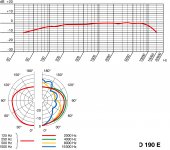I have an AKG D190ES that comes with a frequency response graph. Does it make sense to have this mic calibrated for speaker testing?
Also, what if I use the curve to make a .cal file. I see that the .cal files are nothing more ordered pairs of frequencies and levels. Would that be better than no calibration file?
Also, what if I use the curve to make a .cal file. I see that the .cal files are nothing more ordered pairs of frequencies and levels. Would that be better than no calibration file?
Attachments
This is a dynamic cardioid mic. You need an electret omni IMHO.
Why an electret vs dynamic? Or is it the omni vs cardioid?
G²
Omnis, due to their construction, have a more linear frequency response and polar pattern than uni-directional mics. Condenser or electrets have a flatter response than dynamics and can be made extremely small (with excellent repeatability) to put into a long thin wand which minimizes the interfereance of the measuremic body to the signal to be measured. E
Thank you ... Another problem I found out is that a dynamic mic, even when flat, has a stronger 'proximity effect' in the bass response changes dramatically with distance from the source. Also, recording mics roll off below 100 Hz and this one begins to roll off at 200.
The proximity effect is found on uni-directional (cardoid) mics, that is why crooners like it. Omnis do not have it. E
- Status
- Not open for further replies.
- Home
- Source & Line
- Analogue Source
- AKG D190 ES calibration
